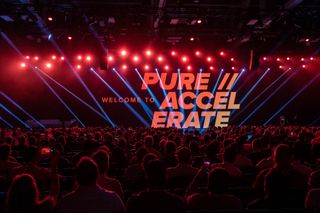Pure Storage pursuing system-based strategy in second decade
CEO says ‘storage shouldn’t be a product-by-product experience’

Pure Storage CEO Charlie Giancarlo has laid out his vision for the company's future, highlighting the importance of the cloud and signalling a move towards a more platform-based approach to storage technology.
The company is celebrating its ten-year anniversary this year and speaking at Pure's annual Accelerate conference in Austin, Texas, Giancarlo told attendees that data needs to be reimagined in the same way that networking and compute have been through virtualisation.
"What we've learned is that we really want these different environments - the application environment, the server environment, the network environment, and now even the data environment - we want it to be flexible. We want it to be a pool of resources that can be used by any application or any environment in any location," he said. "The time came for networking. The time came for server virtualization. And we think the time is right to virtualize the data."
"That is pools of storage with different characteristics, different storage classes, that can be called on demand by API on an enterprise-wide basis, managed by policy, and managed by AI-based management."
The past ten years of Pure's existence have seen a radical shift in enterprise IT as businesses moved to embrace cloud services. The initial hype around cloud services led some to predict that traditional on-premise infrastructure would be rendered obsolete as organisations moved to a purely cloud-based model.
However, while this has vision has given way to a general acceptance that multi-cloud usage models are the more realistic option for most of the market, the rise of cloud storage has forced Pure storage and other historically on-prem vendors to adapt to the new paradigm.
Pure's approach has been to lean into the multi-cloud model, introducing a number of features and products designed to make it easier for customers to integrate its storage arrays into a multi-cloud infrastructure. The most recent of these are the Cloud Block Store for AWS and CloudSnap for Azure offerings, both of which have just gone into general availability.
Get the ITPro. daily newsletter
Receive our latest news, industry updates, featured resources and more. Sign up today to receive our FREE report on AI cyber crime & security - newly updated for 2024.
The company wants to take this even further, however, aiming to make its products the building blocks of a single, unified storage system allowing customers to seamlessly move data and workloads between different storage arrays, tiers and clouds depending on factors like performance requirements, capacity and latency.
"Our first decade was really revolutionising individual storage products. Revolutionising, first of all, what was called Tier 1 storage, really making it 10 times more dense, 10 times more price-effective, and 10 times easier to operate. But to a large extent, it was still the same storage that people were used to buying."
"What we really see in our second decade is that storage shouldn't be about product-by-product experience, it really should be about a system of storage that is easy for the full enterprise: for the application developers, for DevOps. And really, storage should be a set of resources that the entire enterprise can use, rather than dedicated systems that are dedicated to an application by application basis. And so really, we're going to create a system of storage environments rather than individual storage products."
The company has come one step closer to making this kind of unified environment a reality with the launch of its new FlashArray//C, a capacity-optimised flash appliance designed to handle Tier 2 secondary storage tasks. This, the company says, allows it to address multi-tier operations. The next big frontier for Pure is integrating multi-protocol functionality into its portfolio, which the company will do through integrating the technology of Compuverde, a startup that Pure acquired earlier this year.
"When you're multi-cloud, multi-tier and multi-protocol, you now have the basis upon which to start creating storage classes," Giancarlo said. "That is the ability under API to basically define what type of performance level, platform and location you want your storage on, and for that to be provided automatically."
"What we're promising you for our next decade - and actually, it's going to be much shorter than that, over the next several years - is delivering to all apps, all the different protocols, all different storage classes, and every possible cloud, as a service; delivering it all as a service, defined by API. That's what we call a modern data experience."
Adam Shepherd has been a technology journalist since 2015, covering everything from cloud storage and security, to smartphones and servers. Over the course of his career, he’s seen the spread of 5G, the growing ubiquity of wireless devices, and the start of the connected revolution. He’s also been to more trade shows and technology conferences than he cares to count.
Adam is an avid follower of the latest hardware innovations, and he is never happier than when tinkering with complex network configurations, or exploring a new Linux distro. He was also previously a co-host on the ITPro Podcast, where he was often found ranting about his love of strange gadgets, his disdain for Windows Mobile, and everything in between.
You can find Adam tweeting about enterprise technology (or more often bad jokes) @AdamShepherUK.





